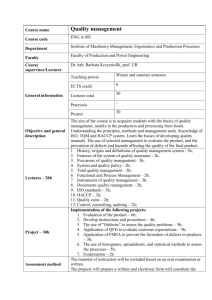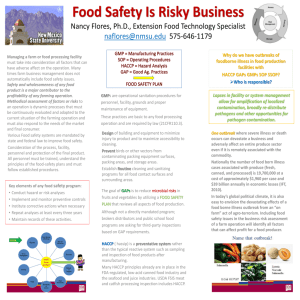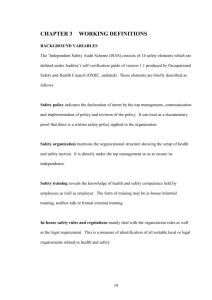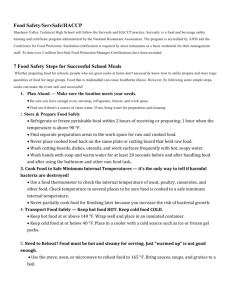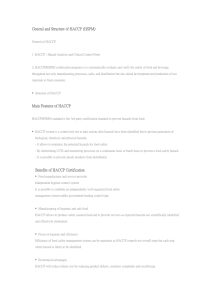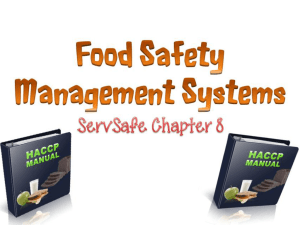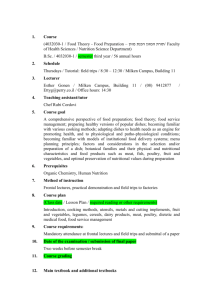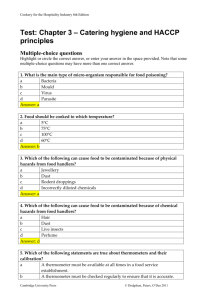Prevent contamination when serving food
advertisement
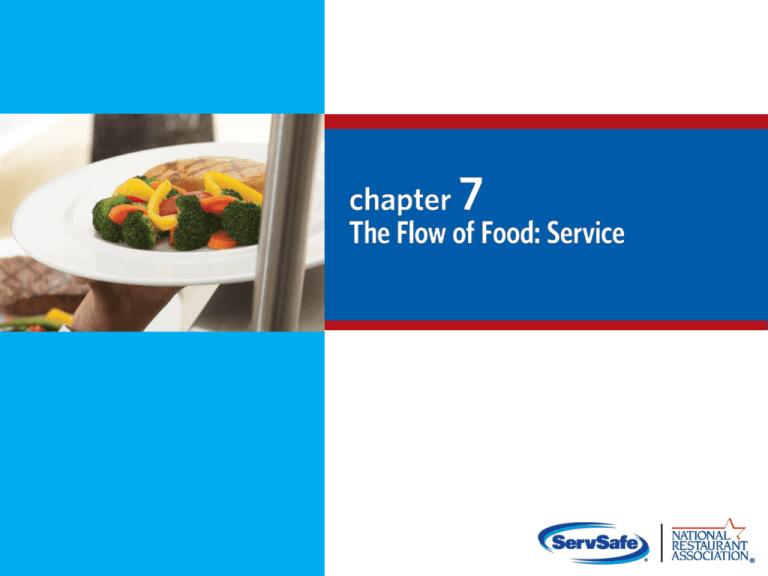
Service Objectives: ● Holding hot food ● Holding cold food ● Using time as a method of control for food ● Preventing contamination in self-service areas and when serving food to customers 7-2 Guidelines for Holding Food Food covers and sneeze guards: Cover food and install sneeze guards to protect food from contaminants o 7-3 Covers protect food from contamination and help maintain food temperatures Guidelines for Holding Food Temperature: 7-4 Hold TCS food at the correct temperature o Hot food: 135°F(57°C) or higher o Cold food: 41°F(5°C) or lower Check temperatures at least every four hours o Throw out food not at 41°F (5°C) or lower o Check temperatures every two hours to leave time for corrective action Guidelines for Holding Food Temperature: NEVER use hot-holding equipment to reheat food unless it’s designed for it o 7-5 Reheat food correctly, and then move it into a holding unit Holding Food Without Temperature Control Cold food can be held without temperature control for up to six hours if: It was held at 41°F (5°C) or lower before removing it from refrigeration It does not exceed 70°F (21°C) during service o It has a label specifying o o 7-6 Throw out food that exceeds this temperature Time it was removed from refrigeration Time it must be thrown out It is sold, served, or thrown out within six hours Holding Food Without Temperature Control Hot food can be held without temperature control for up to four hours if: 7-7 It was held at 135°F (57°C) or higher before removing it from temperature control It has a label specifying when the item must be thrown out It is sold, served, or thrown out within four hours Kitchen Staff Guidelines Prevent contamination when serving food: Wear single-use gloves whenever handling ready-to-eat food o 7-8 As an alternative use spatulas, tongs, deli sheets, or other utensils Use clean and sanitized utensils for serving o Use separate utensils for each food o Clean and sanitize utensils after each task o At minimum, clean and sanitize them at least once every four hours Kitchen Staff Guidelines for Serving Food Prevent contamination when serving food: 7-9 Store serving utensils correctly between uses o On a clean and sanitized food-contact surface o In the food with the handle extended above the container rim Service Staff Guidelines for Serving Food Handling dishes and glassware: Correct Incorrect 7-10 Preset Tableware If you preset tableware: Prevent it from being contaminated o Wrap or cover the items Table settings do not need to be wrapped or covered if extra settings: 7-11 Are removed when guests are seated Are cleaned and sanitized after guests have left Re-serving Food NEVER re-serve: Food returned by one customer to another customer Uncovered condiments Uneaten bread Plate garnishes Generally, only unopened, prepackaged food in good condition can be re-served: 7-12 Condiment packets Wrapped crackers or breadsticks Self-Service Areas Prevent time-temperature abuse and contamination: 7-13 Use sneeze guards o Must be located 14" (36cm) above the counter o Must extend 7" (18cm) beyond the food Identify all food items o Label food o Place salad dressing names on ladle handles Self-Service Areas Prevent time-temperature abuse and contamination: 7-14 Keep hot food at 135°F (57°C) or higher Keep cold food at 41°F (5°C) or lower Keep raw meat, fish, and poultry separate from ready-to-eat food Do NOT let customers refill dirty plates or use dirty utensils at self-service areas Self-Service Areas Prevent time-temperature abuse and contamination: 7-15 Stock food displays with the correct utensils for dispensing food Do NOT use ice as an ingredient if it was used to keep food or beverages cold Labeling Bulk Food in Self-Service Areas When labeling bulk food in self-service areas: Make sure the label is in plain view of the customer Include the manufacturer or processor label provided with the food o 7-16 As an alternative, provide the information using a card, sign, or other labeling method Labeling Bulk Food in Self-Service Areas A label is not needed for bulk unpackaged food, such as bakery products, if: 7-17 The product makes no claim regarding health or nutrient content No laws requiring labeling exist The food is manufactured or prepared on the premises The food is manufactured or prepared at another regulated food operation or processing plant owned by the same person Off-Site Service When delivering food off-site: 7-18 Use insulated, food-grade containers designed to stop food from mixing, leaking, or spilling Clean the inside of delivery vehicles regularly Check internal food temperatures Label food with a use-by date and time, and reheating and service instructions Off-Site Service When delivering food off-site: 7-19 Make sure the service site has the correct utilities o Safe water for cooking, dishwashing, and handwashing o Garbage containers stored away from food-prep, storage, and serving areas Store raw meat, poultry, and seafood, and ready-to-eat items separately Vending Machines To keep vended food safe: Check product shelf life daily o 7-20 Refrigerated food prepped on-site and not sold in seven days must be thrown out Keep TCS food at the correct temperature Dispense TCS food in its original container Wash and wrap fresh fruit with edible peels before putting it in the machine Service Objectives: 8-2 Food safety management systems Active managerial control Hazard Analysis Critical Control point (HACCP) Food Safety Management Systems Food safety management system: 8-3 Group of practices and procedures intended to prevent foodborne illness Actively controls risks and hazards throughout the flow of food Food Safety Programs These are the foundation of a food safety management system: 8-4 Personal hygiene program Food safety training program Supplier selection and specification program Quality control and assurance program Food Safety Programs These are the foundation of a food safety management system: 8-5 Cleaning and sanitation program Standard operating procedures (SOPs) Facility design and equipment maintenance program Pest control program Active Managerial Control Focuses on controlling the five most common risk factors for foodborne illness: 1. Purchasing food from unsafe sources 2. Failing to cook food adequately 3. Holding food at incorrect temperatures 4. Using contaminated equipment 5. Practicing poor personal hygiene 8-6 Active Managerial Control There are many ways to achieve active managerial control in the operation: Training programs Manager supervision Incorporation of standard operating procedures (SOPs) HACCP These are critical to the success of active managerial control: 8-7 Monitoring critical activities in the operation Taking the necessary corrective action when required Verifying that the actions taken control the risks factors Active Managerial Control The FDA provides recommendations for controlling the common risk factors for foodborne illness: 8-8 Demonstration of knowledge Staff health controls Controlling hands as a vehicle of contamination Time and temperature parameters for controlling pathogens Consumer advisories HACCP The HACCP approach: 8-9 HACCP is based on identifying significant biological, chemical, or physical hazards at specific points within a product’s flow through an operation Once identified, hazards can be prevented, eliminated, or reduced to safe levels HACCP To be effective, a HACCP system must be based on a written plan: 8-10 It must be specific to each facility’s menu, customers, equipment, processes, and operations A plan that works for one operation may not work for another The 7 HACCP Principles The seven HACCP principles: 1. Conduct a hazard analysis 2. Determine critical control points (CCPs) 3. Establish critical limits 4. Establish monitoring procedures 5. Identify corrective actions 6. Verify that the system works 7. Establish procedures for record keeping and documentation 8-11 The 7 HACCP Principles Principle 1: Conduct a hazard analysis 8-12 Identify potential hazards in the food served by looking at how it is processed Identify TCS food items and determine where hazards are likely to occur for each one; look for biological, chemical, and physical contaminants The 7 HACCP Principles Principle 2: Determine critical control points (CCPs) 8-13 Find points in the process where identified hazards can be prevented, eliminated, or reduced to safe levels—these are the CCPs Depending on the process, there may be more than one CCP The 7 HACCP Principles Principle 3: Establish critical limits 8-14 For each CCP, establish minimum or maximum limits These limits must be met to o Prevent or eliminate the hazard o Reduce it to a safe level Critical Limit The 7 HACCP Principles Principle 4: Establish monitoring procedures Determine the best way to check critical limits o 8-15 Make sure they are consistently met Identify who will monitor them and how often The 7 HACCP Principles Principle 5: Identify corrective actions 8-16 Identify steps that must be taken when a critical limit is not met Determine these steps in advance The 7 HACCP Principles Principle 6: Verify that the system works Determine if the plan is working as intended Evaluate the plan on a regular basis using 8-17 o Monitoring charts o Records o Hazard analysis Determine if your plan prevents, reduces, or eliminates identified hazards The 7 HACCP Principles Principle 7: Establish procedures for record keeping and documentation Keep records for these actions: 8-18 Monitoring activities Corrective actions Validating equipment (checking for good working condition) Working with suppliers (invoices, specifications, etc.) HACCP These specialized processing methods require a variance and may require a HACCP plan: 8-19 Smoking food as a method to preserve it (but not to enhance flavor) Using food additives or components such as vinegar to preserve or alter food so it no longer requires time and temperature control for safety Curing food Custom-processing animals HACCP These specialized processing methods require a variance and may require a HACCP plan: 8-20 Packaging food using ROP methods including o MAP o Vacuum-packed o Sous vide Treating (e.g. pasteurizing) juice on-site and packaging it for later sale Sprouting seeds or beans
